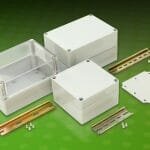~ Small DC motors play an important role in space exploration equipment ~
The Milky Way, the galaxy that holds our solar system, is estimated to be up to 150,000 light years in diameter. Space is vast and enigmatic, making it a focal point for exploration. Studying the mysteries of space requires innovative and robust technology that is up for the challenge. Here Dave Walsha, sales manager at precision drive system supplier EMS, explores the out of this world applications of high performance micromotors.
NASA explains the reasons behind space exploration as a human desire to explore the unknown, push the boundaries of our scientific and technical limits and address fundamental questions about our place in the Universe. The widespread fascination with space exploration is undeniable, and to answer our burning questions, technology must be up to the mark.
Exploration equipment must be engineered to cope with a variety of conditions on planetary bodies and in outer space. For example, Mars has an average temperature of around -60 degrees Celsius and a gravity roughly a third that of Earth, whereas outer space has microgravity, space radiation and extremely low pressure.
Mighty motors
Space exploration equipment such as rovers and probes must operate in harsh conditions under high mechanical stress. The motors that power these pieces of equipment are arguably one of the most important components.
Take rovers for example, where high power micromotors are required to carry out a variety of tasks. A rover can have over 20 onboard cameras, which can be used for navigation during landing and driving on the planetary surface, as well as aiding scientific observations. Micromotors can control the pan and tilt functions of the cameras, as well as the lens filters, and are crucial in obtaining panoramic photographs of the environment.
In addition to obtaining video footage and photographs, rovers can collect surface samples. Rock and soil samples can help scientists learn about the biological and geological history of a moon or planet. Micromotors are crucial for powering the drills that excavate the rock, and the arms that place the sample into onboard storage.
However, micromotors in space are not only restricted to rovers, they’ve been used in probes to wind and unwind measurement cables, help operate a flexible energy storage system and help in landing. Micromotors have even powered service robots that help astronauts with tasks such as scientific experiments and repairs.
Stringent requirements
Once a piece of equipment has been launched into space, it’s crucial that it can perform its job for the required time. If the technology fails, it can significantly delay the research project. It is very rare that the technology can be repaired once in space, due to the high cost of a repair mission.
As well as reliability, it’s important that equipment is designed to have the lowest weight possible. One reason for this is so the technology can be successfully transported into space, but it’s also because rocket fuel is expensive and environmentally damaging. In fact, it can cost around $10,000 to launch one pound of spacecraft into Earth orbit.
Therefore, it’s important to use micromotors that are lightweight and able to deliver high performance and reliability. EMS is the sole UK supplier of FAULHABER motors, which are made in a finely controlled manufacturing process that ensures consistent high quality. Renowned for their high-power density, FAULHABER motors have been used in a number of astronautical engineering projects, such as rovers, probes and service robots.
In 2014, for the first time in history, humanity landed a probe on a comet. The Rosetta space probe revealed that comets may have helped generate life on Earth by providing the necessary materials. In this extraordinary feat, 14 FAULHABER drive systems survived the ten-year journey through the vacuum and exceptionally low temperatures. The drives aided sample collection and operated the flexible energy storage system.
The colossal size of space provides a wealth of opportunity for research and discovery, but its harsh environmental qualities raise challenges for engineering explorative equipment. Fortunately, power dense micromotors that have consistent high quality can power equipment accurately and reliability while adding minimal weight, ensuring that the sky is certainly not the limit.





